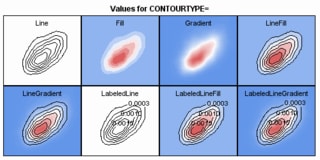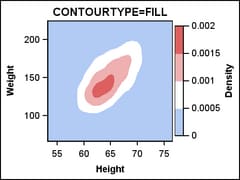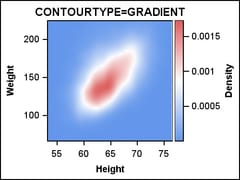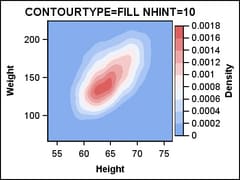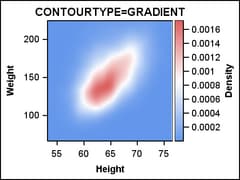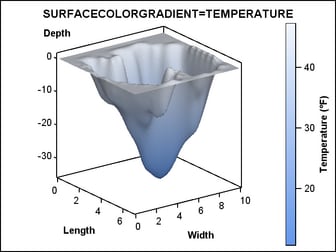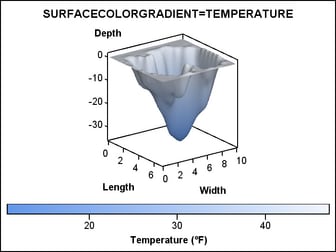Features of Continuous Legends
Plots That Can Use Continuous Legends
A continuous
legend maps the data range of a response variable to a range of colors.
Continuous legends can be used with the following plot statements
when the enabling plot option is also specified.
A contour
plot provides the CONTOURTYPE= option, which you can use to manage
the contour display. The following graph illustrates the values that
are available for the CONTOURTYPE= option.
All of
the variations that support color, except for LINE and LABELEDLINE,
can have a legend that shows the value of the required Z= column.
For example, the following code generates a contour plot with CONTOURTYPE=FILL:
proc template;
define statgraph contour;
begingraph;
entrytitle "CONTOURTYPE=FILL";
layout overlay / xaxisopts=(offsetmin=0 offsetmax=0)
yaxisopts=(offsetmin=0 offsetmax=0);
contourplotparm x=Height y=Weight z=Density / name="cont"
contourtype=fill ;
continuouslegend "cont" / title="Density";
endlayout;
endgraph;
end;
run;
proc sgrender data=sashelp.gridded template=contour;
where height>=53 and weight<=225;
run;
For a
FILL contour, the Z variable is split into equal-sized value ranges,
and each range is assigned a different color. The continuous legend
shows the value range boundaries and the associated colors as a long
strip of color swatches with an axis on it. The contour options NHINT=
and NLEVELS= are used to change the number of levels (ranges) of the
contour. NHINT=10 requests that a number near ten be used that results
in "good" intervals for displaying in the legend. NLEVELS=10 forces
ten levels to be used.
contourplotparm x=Height y=Weight z=Density / name="cont" contourtype=fill nhint=10 ; continuouslegend "cont" / title="Density";
You can
think of a GRADIENT contour as a FILL contour with a very large number
of levels. A color ramp is displayed with an axis that shows reference
points that are within the data range. The number of reference points
is determined by default.
Using Color Gradients to Represent Response Values
Contour
plots and surface plots support the use of color gradients to represent
response values. For example, the SURFACEPLOTPARM statement provides
the SURFACECOLORGRADIENT=numeric-column setting to map surface colors to a continuous gradient and enable
the use of a continuous legend. All surface types (FILL, FILLGRID,
and WIREFRAME) can be used. The COLORMODEL= and REVERSECOLORMODEL=
options also apply. For more information on surface plots, see Using 3D Graphics.
proc template;
define statgraph surfaceplot;
begingraph;
entrytitle "SURFACECOLORGRADIENT=TEMPERATURE";
layout overlay3d / cube=false;
surfaceplotparm x=length y=width z=depth / name="surf"
surfacetype=fill
surfacecolorgradient=temperature
reversecolormodel=true
colormodel=twocoloraltramp ;
continuouslegend "surf" /
title="Temperature ((*ESC*){unicode '00B0'x}F)"
halign=right ;
endlayout;
endgraph;
end;
run;
data lake;
set sashelp.lake;
if depth = 0 then Temperature=46;
else Temperature=46+depth;
run;
/* create smoothed interpolated spline data for surface */
proc g3grid data=lake out=spline;
grid width*length = depth temperature / naxis1=75 naxis2=75 spline;
run;
proc sgrender data=spline template=surfaceplot;
run;
When you
use VALIGN=BOTTOM or VALIGN=TOP instead of the HALIGN= option , then
the default orientation of the legend automatically becomes ORIENT=HORIZONTAL:
continuouslegend "surf" /
title="Temperature ((*ESC*){unicode '00B0'x}F)"
valign=bottom ;
Notice
the coding that is used to embed a degree symbol into the legend title.
For more information on using symbols in text, see Adding and Changing Text in a Graph.
